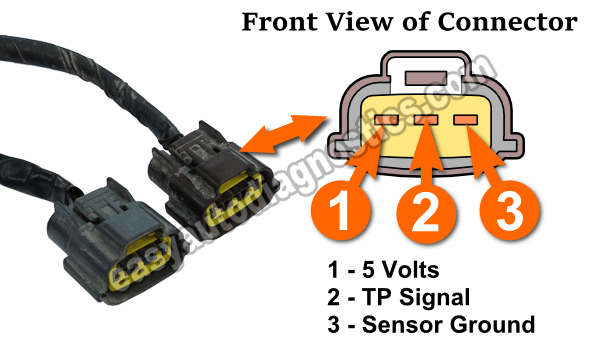TEST 2: Verifying Throttle Position Sensor Has Power

As mentioned in the introduction to TEST 1, the TPS needs power and Ground to produce a throttle angle voltage signal. Testing for power and Ground is done by another round of simple multimeter voltage tests.
Power is in the form of 5 Volts DC and are provided by your Nissan Maxima's PCM (Powertrain Control Module).
The wire, that feeds this power to the TPS, is the one that connects to terminal #1 of the throttle position sensor's brown connector.
Alright, these are the test steps:
- 1
Place your multimeter's dial in Volts DC mode and turn the key on but don't start the engine.
This will power up the TP sensor's connector. - 2
Check the TPS connector terminal that corresponds to pin #1, of the TPS, with the red multimeter test lead.
IMPORTANT Be careful when probing the metal terminal of the TPS connector. Damaging the terminal will require that you replace the connector. Use a back probe or a wire piercing probe instead of probing the front of the connector. - 3
Connect the black multimeter test lead to a good and clean Ground point on the engine or directly on the negative (-) battery terminal.
- 4
When you've set up the test, have a helper turn the Key On Engine Off (KOEO).
- 5
Your multimeter should display 4.5 to 5 Volts on its screen.
Let's interpret your test result:
CASE 1: Terminal #1, of the brown TPS connector, has 4.5 to 5 Volts. So far so good since this tells you that the throttle position sensor (TPS) is getting power from the powertrain control module (PCM).
The next and last test, is to make sure that the throttle position sensor is getting Ground (from the PCM too). For this test, go to: TEST 3: Verifying Throttle Position Sensor Has Ground.
CASE 2: Terminal #1, of the brown TPS connector, DOES NOT have 4.5 to 5 Volts. Double check all of your connections and repeat the test.
If your multimeter still doesn't register the 4.5 to 5 Volts DC, then this test result tells you that the TPS itself is not at fault (and thus causing the TPS trouble code). Without power, the TPS can't create a throttle angle voltage signal. Although beyond the scope of this tutorial, your next step is to diagnose and restore this missing power.
TEST 3: Verifying Throttle Position Sensor Has Ground

To wrap up the throttle position sensor diagnostic, we're going to make sure that it's being fed with Ground.
Ground is supplied by the wire that connects to terminal #3 of the throttle position sensor's brown connector.
IMPORTANT: The PCM is the one that feeds this Ground to the throttle position sensor (TPS). Be careful and don't short this wire to battery voltage or you'll fry the PCM.
OK, here are the test steps:
- 1
Set your multimeter to Volts DC mode.
- 2
Probe the brown TPS connector wire that connects to the connector's terminal #3 with the black multimeter test lead (see illustration above).
Be careful not to damage the terminal if you probe it on the front of the connector. If possible, you should use a back probe or a wire-piercing probe to check this circuit. - 3
Now, with the red multimeter test lead, probe the battery positive (+) terminal.
- 4
Turn the key to its ON position but don't start the engine. This will power up the PCM.
- 5
Your multimeter will display 11 to 12 Volts if the wire, that connects to terminal #3 of the brown TPS connector, is feeding the TPS with Ground.
Let's take a look at your test results:
CASE 1: The multimeter showed 11 to 12 Volts. This test result confirms that the TPS is getting Ground from your Maxima's PCM.
Taking into account the test results of all 3 test, you have confirmed that:
- The TP sensor is not providing a varying voltage signal when manually opening the throttle plate.
- The TP sensor is being fed 5 Volts DC.
- The TP sensor is being fed Ground.
Therefore, you can conclude that the throttle position sensor is bad and needs to be replaced (and that this will solve the TP sensor code lighting up the check engine light). The TPS has to be adjusted to specification if it's replaced. The following tutorial has a section that shows you how in a step-by-step way:
CASE 2: Multimeter DID NOT show 11 to 12 Volts. Double check that you're testing the correct TP sensor harness terminal wire and repeat the test.
If your test result still indicates that the TPS is not getting Ground, then we can conclude that one of two things are causing this lack of Ground:
- There's an open in the wire between the TP sensor harness connector and the PCM's harness connector.
- The PCM has an internal problem (although this is extremely rare).
Although testing these two conditions are beyond the scope of this article, you have now eliminated the throttle position sensor (TPS) on your 3.0L Nissan Maxima as being the cause of the problem and/or the TP sensor diagnostic trouble code (DTC) lighting up the check engine light (CEL).
More 3.0L Nissan Tutorials
You can find a complete list of tutorials in this index: Nissan 3.0L Index Of Articles.
Here's a small sample of the 3.0L Nissan tutorials, you'll find in the index:
- Mass Air Flow (MAF) Sensor Test 3.0L Nissan Quest (1993, 1994, 1995).
- Mass Air Flow (MAF) Sensor Test 3.0L Nissan Maxima (1995-1999).
- How To Test The Starter Motor (Nissan 3.0L, 3.3L) (at: troubleshootmyvehicle.com).
- How To Test Engine Compression (Nissan 3.0L, 3.3L, 3.5L) (at: troubleshootmyvehicle.com).

If this info saved the day, buy me a beer!


